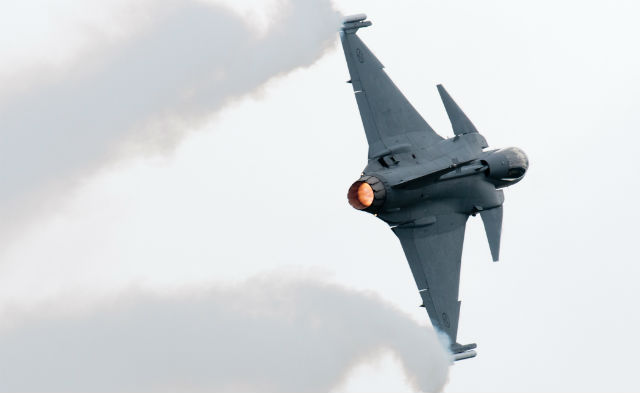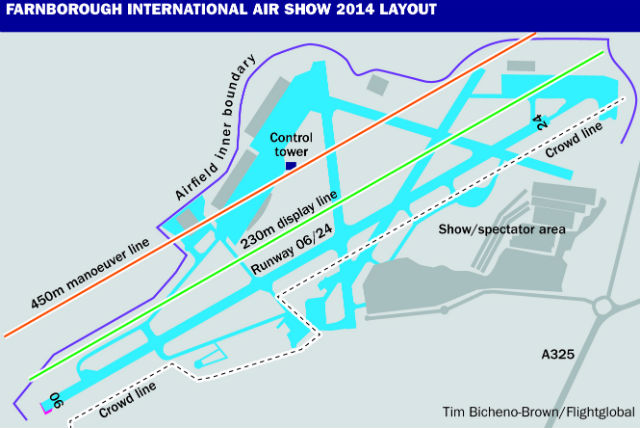When the air display starts each afternoon at the Farnborough International Air Show, business transactions pause and eyes roll heavenward, surrendering to the raucous power play. A major part of the attraction is the evident – if calculated – risk the aviators take.
The organisers of this sky-borne shop window for aviation hardware may appear to have little more to do than arrange the order in which the players make their entrances and their exits. That was indeed true a long time ago. Now, however, both the air display and static park at the show are painstakingly choreographed. The aviators are definitely not given carte blanche.
There is plenty of activity in prospect. The star debutante this year will be a Lockheed Martin F-35B Lightning II, the first jet with vertical landing capability since the British Aerospace Harrier started wowing the crowds in the mid-1960s, flown by the UK Royal Air Force’s Sqn Ldr Hugh Nichols. On the civil side, Airbus’s still-under-test A350 will take its first Farnborough bow. And the organisers have to be prepared for a full aerobatic display team because the Royal Air Force’s Red Arrows will perform on the last three days.
When the Farnborough air show began back in 1948, accidents at air shows, often fatal to pilots and sometimes to onlookers, were not rare. Some of the crashes were the result of test pilots pushing their luck with experimental aircraft in an era of less sophisticated engineering; others were victims of the risk-taking culture left over from the Second World War. Aviators were expected to be dare-devils, and some of them embraced that image with enthusiasm.
Aviation professionalism has evolved as the laws defining corporate responsibility have matured. At Farnborough, in fact, the display is now so organised and premeditated as to be bureaucratic. Display aviators are presented with 76 pages of instructions and restrictions, and in real time, their airborne antics are monitored by a committee armed with an electro-optic tracker. The duty flying display director has direct radio access to the pilots and the authority to order them to abandon their display and land immediately at any time, although he does not actually provide air traffic control during the display – the tower visual control room does that.

Pilots putting types like the Saab Gripen through their paces must adhere to strict guidelines
BillyPix
Indeed, every display pilot, in advance of the show, has to submit a description of the routine and, if it is accepted, attend Farnborough’s “validation week” (7-11 July). At the validation session, pilots fly their routine for the approval of the Flying Control Committee (FCC). Any pilot who busts a datum is either excluded or has to re-validate. Even the Red Arrows have to undergo validation, although they are permitted to fly some manoeuvres lower over the aerodrome than any other “act”, on the basis that their entire raison d’êtreis display flying, whereas for other aircraft, the display routine is a means to an end – the demonstration of aircraft performance.
Yet despite this ostensibly deadening carefulness, the display normally contrives to be as exciting as it ever was. The thrills are heightened, of course, by the performance of phenomenally powerful air superiority fighters that appear to defy physics because of their engineered instability. Giant airliners elegantly do the same, but with hardly a sound. Finally – a relatively new display experience – unnerving mini-unmanned air vehicles throng like annoying insects as they show off their busybody routines.
Sarah Harding is Farnborough International’s head of flight operations, and for the management of the air display she liaises with external consultant John Turner, the flying display director. Turner heads the FCC, many of whose members are current or former display pilots. Turner and his team are directly responsible to the UK Civil Aviation Authority for ensuring that the display is safe, not only for those attending the air show, but those living and working nearby, and for all the non-Farnborough airborne traffic pursuing its normal business in the UK’s busy southeastern airspace. Years of experience at making Farnborough work safely have resulted in flying routines and patterns being delineated precisely by on-airfield territorial designators, like the display datum, the display line, manoeuvre line, crowd line and aerodrome boundary (see diagram), all of them dictated by the orientation of Farnborough’s only active runway, 06/24.

There are external limits also: the CAA and UK air navigation service provider NATS permit the creation of a temporary restricted airspace zone during the show, a radius of 6nm from the airfield display datum up to 8,000ft, which is sufficient for the Red Arrows to carry out their full display. Within that, the main limit for display flying is a 2nm (3.7km) radius from the display datum, within which the minimum operating height above airfield level is 1,000ft, and beyond it 2,000ft. Within that is an inner circle with a radius 1nm from the datum, in which aircraft may descend to the minimum display height of 800ft, unless given a lower minimum specific to the type of display. There are two temporary holding patterns designed for airborne display aircraft while they await their stage entrance: one to the west, its datum based on an Ockham VOR radial and distance measuring equipment range, and the other to the south on a waypoint defined by a Compton radial/DME.
As for the order in which aircraft display, Harding coordinates that, taking into account parking capacity, taxiway space, aircraft size, and even press conference times.
Meanwhile, during the display, Farnborough continues to be a working airport as far as it can. The airport is owned by fixed-base operator TAG Aviation, which has its business aviation terminal and hangars on the runway north side. Farnborough is the London area destination of choice for large numbers of business aircraft users. Arrivals and departures for the show have to be arranged with TAG, which also operates the tower.
In the afternoon, once the air display has begun, non-display arrivals and departures are permitted only within two five-minute gaps, so anyone planning to attend the show using a private or chartered aircraft is well advised to plan a morning or evening movement. The moment the last display aircraft has landed, normal service resumes.
All details, regulations and restrictions are on the Farnborough International Air Show website.
Air display risk
Farnborough accidents in history
- 6 September 1952, De Havilland 110 strike fighter. Both crew and 29 spectators were killed when the tail broke off and the aircraft disintegrated following a supersonic dive. The air display continued despite this shock event.
- 20 September 1968, Breguet 1150 Atlantic crashed during a single-engine demonstration killing all five crew and one person on the ground.
- 11 September 1970, Wallis Autogyro went out of control. Pilot killed.
- 1 September 1974, Sikorsky Black Hawk helicopter crashed on the runway after a low roll, killing both crew.
- 4 September 1984, de Havilland Canada DHC-5D Buffalo, badly judged steep approach to an intended short landing in a gusting crosswind resulted in serious structural damage at touchdown. No casualties.
Accidents at other UK air shows (excluding warbird displays)
- 18 September 1948, RAF Manston. De Havilland Mosquito. Both crew and 10 spectators were killed.
- 20 September 1958, RAF Syerston, Avro Vulcan wing structural failure following pull-up exceeding structural limits. All crew and three people on the ground died.
- 24 July 1993, Royal International Air Tattoo, RAF Fairford, two Russian AF Mig Mi29s collided and crashed. The pilots ejected, no casualties.
- 20 August 2011, Bournemouth, BAE Systems Hawk T1 crashed at the end of an air display by the RAF aerobatic team, the Red Arrows, when the pilot suffered g-induced loss of consciousness. The pilot was killed.
Get all the latest coverage from Farnborough here
Source: Flight International























